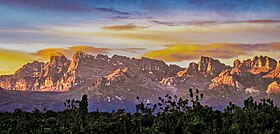| Lorentz National Park | |
|---|---|
| Taman Nasional Lorentz | |
 Lorentz National Park | |
| Location | Central Papua, Indonesia |
| Nearest city | Timika |
| Coordinates | 4°45′S 137°50′E / 4.750°S 137.833°E |
| Area | 25,056 km2 (9,674 sq mi) |
| Established | 1997 |
| Governing body | Ministry of Environment and Forestry |
| World Heritage site | 1999 |
| Website | tamannasionallorentz |
| Criteria | Natural: viii, ix, x |
| Reference | 955 |
| Inscription | 1999 (23rd Session) |
Lorentz National Park is an Indonesian national park located in the provinces of Central Papua, Highland Papua and South Papua, in the southwest of western New Guinea. With an area of 25,056 km2 (9,674 mi2), it is the largest national park in Southeast Asia. In 1999 Lorentz was declared a World Heritage Site by UNESCO.

An outstanding example of the biodiversity of New Guinea, Lorentz is one of the most ecologically diverse national parks in the world. It is the only nature reserve in the Asia-Pacific region to contain a full altitudinal array of ecosystems ranging through marine areas, mangroves, tidal and freshwater swamp forest, lowland and montane rainforest, subalpine shrub and grassland, alpine tundra, and equatorial glaciers. At 4884 meters, Puncak Jaya (formerly Carstensz Pyramid) is the tallest mountain between the Himalayas and the Andes.
Birdlife International has called Lorentz Park “probably the single most important reserve in New Guinea”.[1] It contains five of World Wildlife Fund's "Global 200" ecoregions: Southern New Guinea Lowland Forests; New Guinea Montane Forests; New Guinea Central Range Subalpine Grasslands; New Guinea Mangroves; and New Guinea Rivers and Streams.[2]
Lorentz Park contains many unmapped and unexplored areas, and is certain to contain many species of plants and animals as yet unknown to Western science. Local communities' ethnobotanical and ethnozoological knowledge of the Lorentz biota is also very poorly documented.
The park is named for Hendrikus Albertus Lorentz, a Dutch explorer who passed through the area on his 1909–10 expedition.
- ^ Birdlife International, 1999, retrieved 14 May 2010
- ^ WWF Ecoregions, retrieved 14 May 2010